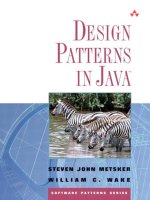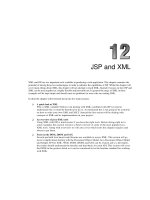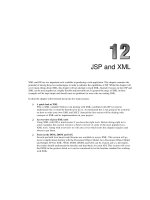New riders digital lighting and rendering 2nd edition apr 2006 ISBN 0321316312
Bạn đang xem bản rút gọn của tài liệu. Xem và tải ngay bản đầy đủ của tài liệu tại đây (9.63 MB, 623 trang )
DigitalLighting&Rendering,SecondEdition
ByJeremyBirn
...............................................
Publisher:NewRiders
PubDate:April27,2006
PrintISBN-10:0-321-31631-2
PrintISBN-13:978-0-321-31631-8
Pages:432
TableofContents|Index
Craftingaperfectrenderingin3Dsoftwaremeansnailingallthedetails.Andnomatter
whatsoftwareyouuse,yoursuccessincreatingrealistic-lookingillumination,shadowsand
texturesdependsonyourprofessionallightingandrenderingtechniques.Inthislavishly
illustratednewedition,Pixar'sJeremyBirnshowsyouhowto:
MasterHollywoodlightingtechniquestoproduceprofessionalresultsinany3D
application
Convincinglycomposite3Dmodelsintoreal-worldenvironments
Applyadvancedrenderingtechniquesusingsubsurfacescattering,global
illumination,caustics,occlusion,andhighdynamicrangeimages
Designrealisticmaterialsandpaintdetailedtexturemaps
Mimicreal-lifecamerapropertiessuchasf-stops,exposuretimes,depth-of-field,and
naturalcolortemperaturesforphotorealisticrenderings
Renderinmultiplepassesforgreaterefficiencyandcreativecontrol
Understandproductionpipelinesatvisualeffectsandanimationstudios
Developyourlightingreeltogetajobintheindustry
DigitalLighting&Rendering,SecondEdition
ByJeremyBirn
...............................................
Publisher:NewRiders
PubDate:April27,2006
PrintISBN-10:0-321-31631-2
PrintISBN-13:978-0-321-31631-8
Pages:432
TableofContents|Index
Copyright
Foreword
ChapterOne.FundamentalsofLightingDesign
Motivation
Cheating
VisualGoalsofLightingDesign
LightingChallenges
YourWorkspace
CreativeControl
ChapterTwo.LightingBasicsandGoodPractices
StartingPoints
TypesofLights
ControlsandOptions
LightinginProduction
Exercises
ChapterThree.ShadowsandOcclusion
TheVisualFunctionsofShadows
WhichLightsNeedShadows?
ShadowColor
ShadowSizeandPerspective
ShadowAlgorithms
HardandSoftShadows
Occlusion
FakingShadows
Conclusions
Exercises
ChapterFour.LightingEnvironmentsandArchitecture
Daylight
NightScenes
PracticalLights
LightingWindows
SimulatingIndirectLight
GlobalIllumination
AmbientOcclusion
Exercises
ChapterFive.LightingCreatures,Characters,andAnimation
ModelingwithLight
Three-PointLighting
FunctionsofLights
IssuesinLightingCharacterAnimation
Exercises
ChapterSix.CamerasandExposure
UnderstandingF-StopsandDepthofField
FrameRates
RealisticMotionBlur
FilmSpeed
PhotographicExposure
MatchingLensImperfections
Exercises
ChapterSeven.CompositionandStaging
TypesofShots
CameraAngles
ImprovingYourComposition
FramingforFilmandVideo
Exercises
ChapterEight.TheArtandScienceofColor
ColorMixing
ColorSchemes
ColorBalance
UnderstandingRGBColor
DigitalColor
Exercises
ChapterNine.ShadersandRenderingAlgorithms
ShadingSurfaces
Anti-Aliasing
Raytracing
ReyesAlgorithms
Z-BufferRendering
ScanlineRendering
GPU-AcceleratedandHardwareRendering
Exercises
ChapterTen.DesigningandAssigningTextures
TypesofTextureMapping
PhotographicTextures
StylizedTextures
TextureMapResolution
AlignmentStrategies
ProceduralTextures
LooksDevelopment
Exercises
ChapterEleven.RenderingPassesandCompositing
RenderinginLayers
AlphaChannelIssues
RenderinginPasses
LightingintheComposite
MatchingLive-ActionBackgroundPlates
Exercises
ChapterTwelve.ProductionPipelinesandProfessionalPractices
ProductionPipelines
GettingWorkApproved
Index
Copyright
DigitalLightingandRendering,SecondEdition
JeremyBirn
NewRiders
1249EighthStreet
Berkeley,CA94710
510/524-2178
800/283-9444
510/524-2221(fax)
FindusontheWebat:www.newriders.com
Toreporterrors,pleasesendanoteto
NewRidersisanimprintofPeachpit,adivisionofPearson
Education
Copyright©2006byNewRiders
ProjectEditors:DavinaBaum,KristinKalning
DevelopmentEditor:DavinaBaum
ProductionEditor:AndreiPasternak
Copyeditor:EmilyWolman
TechEditor:JesseBrophy
Compositor:MaureenForys,HappenstanceType-O-Rama
Proofreader:CorbinCollins
Indexer:JoyDeanLee
Coverdesign:ArenHowell
Interiordesign:MaureenForys,HappenstanceType-O-Rama
NoticeofLiability
Theinformationinthisbookisdistributedonan"AsIs"basis
withoutwarranty.Whileeveryprecautionhasbeentakeninthe
preparationofthebook,neithertheauthornorPeachpitshall
haveanyliabilitytoanypersonorentitywithrespecttoany
lossordamagecausedorallegedtobecauseddirectlyor
indirectlybytheinstructionscontainedinthisbookorbythe
computersoftwareandhardwareproductsdescribedinit.
Trademarks
Manyofthedesignationsusedbymanufacturersandsellersto
distinguishtheirproductsareclaimedastrademarks.Where
thosedesignationsappearinthisbook,andPeachpitwasaware
ofatrademarkclaim,thedesignationsappearasrequestedby
theownerofthetrademark.Allotherproductnamesand
servicesidentifiedthroughoutthisbookareusedineditorial
fashiononlyandforthebenefitofsuchcompanieswithno
intentionofinfringementofthetrademark.Nosuchuse,orthe
useofanytradename,isintendedtoconveyendorsementor
otheraffiliationwiththisbook.
987654321
PrintedandboundintheUnitedStatesofAmerica
NoticeofRights
Allrightsreserved.Nopartofthisbookmaybereproducedor
transmittedinanyformbyanymeans,electronic,mechanical,
photocopying,recording,orotherwise,withoutthepriorwritten
permissionofthepublisher.Forinformationongetting
permissionforreprintsandexcerpts,contact
Figure1.5,page13,usedcourtesyofCtrlstudio,Angel
Camacho,YohanndaGeb,DonalKhosrowi,LazharRekik,
HolgerSchömann,AndrzejSykut,andFlorianWild.Allrights
reserved.
ThemodelusedinFigures2.16and2.19,pages31and36,
usedcourtesyofRiniSugianto.Allrightsreserved.
Chapter4openingspreadimage,page84,usedcourtesyof
AmiltonDiesel.Allrightsreserved.
Figure4.27,page111,usedcourtesyofJasonLee.Allrights
reserved.
Figure4.28,page111,usedcourtesyofGeoffPacker.Allrights
reserved.
Chapter5openingspreadimage,page124,usedcourtesyof
KimHyungJun.Allrightsreserved.
Figure6.5,"CircusMaximumIrritans,"page162,usedcourtesy
ofPéterFendrik.Allrightsreserved.
Figure7.2,page188,andFigure8.8,page221,usedcourtesy
ofJorgeR.Gutierrez.Allrightsreserved.
Figure7.7,page195,byAndrewHickinbottom,©2006Andrew
Hickinbottom.Allrightsreserved.
Figure8.12,page226,usedcourtesyofVaclavCizkovsky.All
rightsreserved.
Figure10.13,"VenetianBoatSong,"page293,byGladysLeung
©2006().Allrightsreserved.
Figures10.19,10.20,10.21,and10.22,pages300,301,and
302,usedcourtesyofEniOken.Allrightsreserved.
Foreword
Tohelpyoumakebetter3Drenderings,thisbookfuses
informationfromseveralfields.Inthesepagesyouwillfind
conceptsandtechniquesfromprofessionalcinematography,
designprinciplesfromtraditionalvisualarts,practicaladvice
basedonprofessionalfilmproductionexperience,andplainEnglishexplanationsofthelatestsciencebehindthescenes.
WhoShouldReadThisBook?
Youshouldreadthisbookwhenyouhaveatleastaworking
knowledgeofhowtousea3Dpackage,andareinterestedin
takingyour3Drenderingfurther.
Forprofessionalusersof3Drenderingsoftware,thisbookis
designedtohelpwithreal-worldproductionchallengesand
contributetotheongoinggrowthofyourwork.
Forstudentsofcomputergraphics,thisbookwillhelpyou
developmoreprofessionalrenderingskills.
Fordedicated3Dhobbyists,thisbookcanhelpyouimprove
theartisticqualityofyour3Drenderingsandlearnmore
aboutprofessionalapproachestographicsproduction.
Thisbookiswrittentobeclear,butnotcondescending.Every
efforthasbeenmadetodefinetermsthefirsttimetheyare
used,andtoillustrateeveryconceptandtechniquewithfigures
andsamplerenderings.Thisbookisdesignedtocomplement,
ratherthantoreplace,yoursoftware'smanualsandhelpfiles.
Mostoftheinformationyoufindhereisnotinyoursoftware's
manual,evenifsomeofitshouldbe.
SoftwareRequirements
Thisbookcoverstechniquesandconceptsthatareapplicableto
workinalmostany3Drenderingsoftware.2DPaintand
compositingsoftwareisalsorecommended.
3DSoftware
Nosingleprogramisgoingtosupporteveryfeature,function,
andrenderingalgorithmdescribedinthisbook.Hopefullyyou
won'tmindlearningaboutafewfunctionsthataren'tinyour
particularsoftwareyet.However,mostsectionsshowseveral
alternateapproachesorwork-aroundssothatyoucanachieve
anyeffectthatisdescribed,nomatterwhichprogramyouuse.
Beingnon-software-specificdoesn'tmeanthatthisbookdoesn't
discussparticularsoftware,though.Ifthere'sanoteworthy
featureinRenderman,MentalRay,3DStudioMax,Maya,
Softimage,Lightwave,oranyotherprogram,itwillbe
mentionedwhenitcomesup.
Thisbookisdedicatedtotheideathat,withanawarenessof
theartandcomputergraphicsprinciplesthatgointoa
rendering,andalittlebitofcreativeproblemsolving,youcan
accomplishgreatworkinalmostanyrenderingpackage.
2DSoftware
Anygood3Dsystemshouldbecomplementedwith2Dsoftware
tocreateandmanipulatetexturemaps,andtocomposite
togetherlayersandrenderpasses.Ideallyyoushouldhavea
paintprogramsuchasAdobePhotoshop(usedinmanytexturecreationexamplesinthisbook),PaintShopPro,orFractal
Painter.FreealternativessuchasTheGimporPaint.NETwill
alsoworkjustfine.Adedicatedcompositingprogram,suchas
Shake,DigitalFusion,orAfterEffects,isusefulwhen
compositingtogetherrenderpasses,althoughyoucouldalsodo
basiccompositingofstillimagesinyourpaintprogram.
AboutThisEdition
Thisisthesecondeditionofthepopularbook[Digital]Lighting
&Rendering.Thefirsteditionbecamethestandardtextonthe
artof3Dlightingandrendering,andintroducedmanyartiststo
thefield.Sinceitwaspublishedin2000,ithasmetwithgreat
criticalandcommercialsuccess.Iamsincerelygratefultoeach
teacherwhohaschosentoassignmybooktostudents,
everyoneontheInternetwhohaspostedarecommendation,
andeveryartistwhohasshownmybooktoafriendor
colleague.
Thisneweditionhasadvancedalongwithchangesin
technology,insoftware,andintheindustry.Tokeepupwithan
evolvingfield,everychapterhasgrownwithnewtechniques
andconcepts.Issuessuchasocclusionandglobalillumination,
whichhadbeenrelegatedtosinglesectionsinthefirstedition,
arenowwoventhroughoutthebook,indiscussionsofdifferent
issuesfromarchitecturalrenderingtorenderpasses.Anew
chapterhasalsobeenaddedonunderstandingstudio
productionpipelineshowprofessionalsworktogetherindifferent
positionstocreatefeature-filmvisualeffectsandcomputer
animatedfeatures.
Incomputergraphics,wesayourworkisneverreally
completed,onlyabandoned.Shotsalwayscouldbebetter,
alwayscouldbetweakedandrevisedalittlemoreby
perfectionistartists.Crashingintoadeadlineiswhatfinally
forcesustoletgooftheprojectswelove.Thesameistruein
releasingabook.I'mgladthatwhatIabandonedin2000has
madesomanypeoplehappy.Thefirsteditionrepresentedthe
bestofwhatIhadtosaythatyear.SincethenIhavecontinued
toworkintheindustry,gainingexperienceinvisualeffectsand
animatedfeatureproduction,workingwithdifferentapplications
andrenderers,teachingcoursesonlightingandrendering,and
IhavehadampletimetoregreteverywordthatIwrote.Being
abletorevisitandreviseallofthismaterialhasbeenagreat
pleasure,anditiswithgreatpridethatIabandonthisnew
editiontoyou.
ChapterOne.FundamentalsofLighting
Design
FruitBowlimagesbyDonalKhosrowi(top)andAndrzejSykut
(lower).
Thecraftoflightingdesignwaspracticedforcenturiespriorto
theadventofcomputergraphics,infieldssuchastheater,
painting,photography,andcinematography.3Dartistshavea
greatdealtolearnfromthetraditionsofearlierlighters.This
chapterprovidesanintroductiontosomeofthekeytermsand
conceptsinthefieldoflightingdesign,andlooksaheadtosome
oftheimportantissuesandchallengesthatwillberaisedinthis
book.
Motivation
Beforeyouaddalighttoyourscene,youshouldknowits
motivation.Motivationisthecauseororiginalsourceforeach
lightinyourscene.
Youprobablywouldn'tbegintoanimateacharacterwithout
knowingwhatthecharacterwasdoingortryingtodo,orpaint
atexturemapwithoutknowingwhatmaterialyouweretrying
tocreateandyetmanypeopleaddlightstotheirscenesinjust
thissortofrandommanner,withoutthinkingaboutwhatkindof
lighttheyaretryingtodepict.
Motivationshouldinformeverydecisionyoumakeinadjusting
yourlights.Onceyouknowalight'smotivation,youknowwhat
qualitiesofreallightyouaretryingtodepict,andwhatkindof
lightsourcesyoushouldstudyorthinkaboutwhencreatingan
appearancein3D.
Off-ScreenSpace
Off-screenspaceistheareathatisn'tvisibleinyourshot,such
asthespaceabovethecamera.Theillumination,shadows,and
reflectionsyouseeinaphotographareoftenmotivatedbyoffscreensources,ratherthanbylightsourcesthatarevisible
withintheframe.Animportantpartofyourjobindesigning
lightingforanysceneistoimaginewhatexistsinoff-screen
space,sothatyoucanlightyourscenewithlightsthatappear
tobemotivatedbyreallightsources.
Toseehowlightingcanbeshapedbyoff-screenspace,takea
lookatthefourphotographsinFigure1.1.Theobjectsinthe
framedon'tchange,andyetbasedonthelightcomingfromoffscreen,youcantellagreatdealaboutwhereeachpicturewas
taken.
Figure1.1.Youcanrecognizeascenelitbya
lamp(upperleft),bylightthroughawindow
(upperright),underacloudysky(lowerleft),
andindirectsun(lowerright).
Ifthelightcomingfromoff-screenspaceinaphotographcan
providethismuchinformation,howdowemakethelightingin
our3Dscenesappearjustasdistinctivetocommunicatethe
samethings?Theanswerstartswithstudyingthevisible
qualitiesoflightfromeachkindoflightsource.
QualitiesofLight
Werecognizedifferentsourcesofilluminationbythedifferent
qualitiesoflighttheyaddtothescene.Themainqualitiesof
lightthatwenoticeinapicturearecolor,brightness,softness,
throwpattern,andangle.
Everytypeoflightsourcehasadistinctivecolor
temperature,which,whencombinedwiththewhitebalance
ofthecamera,determinesthecolorofthelight.Chapter8,
"TheArtandScienceofColor,"haschartsofreallight
sources'colortemperatures.
Brightness,likecolor,isallrelativetohowthecamerais
adjustedthistimebasedontheexposuresettingsofthe
camera.Chapter6,"CamerasandExposure,"describesa
realcamera'sexposureprocess,andhowtomakesureyour
ownrenderingsareexposedproperly.
Softnessisafunctionofseveralsettingsonalight.The
penumbraofaspotlightsetsthesoftnessoftheedgeofits
cone.Thedecayordrop-offofalightsetshowitfades
awaywithdistance.Mostimportantly,softshadowscreate
theimpressionofsoft,diffusedlightwhilecrisplydefined
shadowsindicatehardlight.Figure1.1showedthehardedgedshadowsofthechesspieceslitbydirectsun,andthe
muchsoftershadowscastbythecloudysky.Chapter3,
"ShadowsandOcclusion,"discussesseveralapproachesto
renderinghardandsoftshadows.
Throwpattern,ortheshapeofalight,isanothernoticeable
qualityoflight.Figure1.1showedthepatternofthelight
filteredthroughVenetianblindsasthethrowpatternof
sunlightthathaspassedthroughawindow.Chapter2,
"LightingBasicsandGoodPractices,"discussesprojecting
cookiesfromyourlightstosimulatedifferentthrow
patterns.
Alight'sangletellsyouwhereitiscomingfrom.For
example,alateafternoonsunwillcomefromalowerangle
thanlightinthemiddleoftheday.Toalightingdesigner,
anglealsohelpsdeterminethevisualfunctionofalight,
suchaswhetheritfunctionsasakeylight,akicker,ora
rim.Aiminglightsatthecorrectangletoachievedifferent
visualfunctionsisdescribedinChapter5,"Lighting
Creatures,Characters,andAnimation."
Almostanyadjectiveyouusetodescribelightcouldbe
consideredaqualityoflight.Isometimesconsideranimation,
suchaswhetheralightisflickeringorconsistent,tobea
qualityoflight.Ihaveheardotherpeopledescribethelevelof
contrastasaqualityoflight,althoughIconsidertheamountof
contrastinanimagetobeafunctionofthebrightnessand
softnessofthelightsinthescene.
Theonethingthattiesallofthesequalitiesoflighttogetheris
thatyoucanstudytheminreallife,andworktoimitatethem
withthelightsinyour3Dscene.Knowingwhichkindsoflight
youwanttostudyinreallifestartswithimaginingwhatkindsof
lightsourcesaremotivatingyourscene'sillumination.
DirectandIndirectLight
Directlightshinesdirectlyfromanoriginalsource,suchasa
lightbulborthesun,toanobjectthatitilluminates.Indirect
lightislightthathasreflectedorbouncedoffonesurface
already,beforeitindirectlyilluminatesotherobjects.For
example,ifafloorlampaimslightattheceiling,thenthecircle
oflightontheceilingisdirectlight.Thelightthathasreflected
offtheceilingtosoftlyilluminatetherestoftheroomisindirect
light.
Directlightsourcesareusuallythemotivationformostofthe
brighterlightsinyourscene,butindirectlight,suchaslight
thathasbouncedoffthegroundorawall,isalsoamotivation
forlightthatcanfillinorilluminatepartsofyourscene.
Chapter4,"LightingEnvironmentsandArchitecture,"explains
howtosetupextralightstosimulateindirectlightbouncesin
anenvironment,aswellasglobalilluminationfunctionsthat
automatethesimulationofindirectlight.
Cheating
Cheatingisanintentionaldeparturefromwhat'smotivated,
doneinawaydesignednottoappearnoticeablywrongtothe
audience.
Asasimpleexampleofcheating,Figure1.2showsthe
environmentthatIbuilttorepresenttheoff-screenspace
surroundingthefruitbowlonthecoverofthisbook.Itcontains
thewindowthatwillbereflectedonthesurfaceofthefruits.
Thatwindowinthereflectionisalsothemotivationforthekey
light(themain,brightestillumination)illuminatingtheleftside
ofthefruitsinthescene.
Figure1.2.Atexturedenvironmentsurroundsthe
fruitbowlinthelowerright.
Ifweweren'tdoinganycheatingandstuckwithwhatwas
motivated,thenthekeylightwouldbepositionedexactlywhere
thewindowis,sothattheilluminationonthefruitcamefrom
thesameangleasthereflectionofthewindow.However,doing
thiswouldlightthefruittoofrontally,whichwouldappearto
flattenouttheroundforms.Theshapeofthefruitwillbebetter
definedbylightthatcomesmorefromthesideinsteadofthe
front.Toaccomplishthis,thepositionofthelightischeated
awayfromthewindowthatmotivatesit,asshowninFigure
1.3.
Figure1.3.Themotivatedpositionforthekey
light(orange)wouldmatchthereflection,butthe
newkeylightpositionischeatedawayfromthe
window(green).
Figure1.4comparesthefruitlitfromtheactualwindowposition
tothefruitlitfromthecheatedangle.
Figure1.4.Illuminationfromtheoriginalangle
(left)doesn'tshapeallofthefruitaswellaslight
fromthecheatedposition(right).
Cheatingisperformed,tosomeextent,onalmosteveryproject
donein3D.Shadowscastfromonecharactertoanotherare
movedorremovediftheyaredistracting.Lightonacharacter
thatappearstocomefromalampmayactuallycomefroma
positionfarawayfromthelampifitlightsacharacterbetter.
Rimsoflightperfectlyoutlineforms,eveniftherewasnolight
inexactlytherightplacetomotivatetherim.
CheatinginLiveAction
Knowinghowtocheatandfakethingsisacrucialpartof
creating3Dgraphics,butitisalsoanestablishedpartoftheart
oflive-actioncinematography.
Apooloflightonthefloorthatappearstohavecomefroma
windowmayactuallycomefromalightabovetheset.Anactor
runningintoadarkforestmayhavehisfacefullylitwhenin
realityhewouldhavebeenindarkness.Eventhewallsofthe
setaresometimesmountedonwheels(thisiscalledawild
wall)sothattheycanbemovedoutoftheway,orrotated
independentlyfromotherwalls.
Sowhydolightingdesignerscheat?Whynotjustmakethe
lightingbeasaccurateandtrue-to-lifeaspossible?Theshort
answertothesequestionsisthatlightingandcinematography
arearts,notjustsciences.Amorein-depthanswerstartswith
understandingthevisualgoalsthatalightingdesigneristrying
toachieveinlightingascene.
VisualGoalsofLightingDesign
Thereismoretolightingascenethansimplyrunninga
simulationofreal-worldparameters.Lightingisalsodesignedto
achievecertainvisualgoalsthathelpaviewerbetterappreciate
ascene.Howwellalightingartistaccomplishesthesegoals
determineshowthelightingwillenhanceordetractfromashot.
MakingThingsRead
Muchlikephotography,cinematography,andpainting,3D
renderingisaprocessofproducingtwo-dimensionalimages
thatdepictthree-dimensionalscenes.Togiveyourrenderings
solidityandpresence,andtofullycommunicatethethreedimensionalformofanobjectorcharactertoanaudience,you
needtodefineyourmodelswithcarefullighting.Somepeople
callthisprocessmodelingwithlight,becauseitisyourlighting
thatletstheviewerperceiveanobject's3Dform.Defininga
characterwithlightisoneofthemainfocusesofChapter5.
MakingThingsBelievable
Computergraphicscanberenderedinmanydifferentvisual
styles.Someprojectsrequirephotorealism(imagesthatcanbe
mistakenforaphotograph),whileotherprojectsarestylizedin
differentwaysordesignedtocreatemoreillustratedorcartoonlikelooks.However,whetherornotthevisualstyleyouadoptis
photorealistic,yourlightingstillneedstobebelievabletothe
audience.
Abelievableimageisatleastinternallyconsistent,withlights
balancedinawaythatwouldbemotivatedinreallife.For
example,ifthereisabeamofdirectsunlightenteringaroom,
theviewerexpectsthesunlighttobebrighterthanthelightofa
tablelamp.Eveninacartoon,basicexpectationsofweightand
balancestillexist,andsometimesgettingsmalldetailsrightin
yourlightingcanevenhelp"sell"ascenethatotherwisewould
beimpossibletobelieve.
Oftenthekeytocreatingbelievablelightingisstudyingreallife.
Beforebeginningaproject,trytostudyhowlightbehavesin
situationssimilartowhatyouwillberendering.Invisualeffects
work,studyingthelive-actionfootage(theimagesfilmedwitha
realcamera)canshowyouagreatdealabouthowasubject
shouldappearinanenvironment.Forprojectscreatedentirely
in3Dgraphics,collectreferenceimagesthatyoucanstudyto
seehowcolorandlightwouldappearinarealscene.Whether
youphotographthereferenceimagesyourself,findthemona
photographywebsite,orgrabstillframesfromrentedDVDs,
yourcollectionofreferenceimagescanbeusefulthroughout
yourprojecttocomparewithyourrenderingsasyoudesignand
adjustyourlighting.
Itisapoorartistwhoblameshistoolsforhiswork.Partof
makingascenebelievableiscompensatingforthefailures,
flaws,andlimitationsinherentinyourrenderingsoftware.
Almosteveryphysicaleffectdiscussedinthisbook,from
indirectlightbouncingoffwallstothetranslucencyinhuman
skin,canbesimulatedthroughcarefultexturing,lighting,and
compositing,evenwhenyoursoftwaredoesn'tfullyor
automaticallysimulateeverythingforyou.Whensomeonesees
thepictureoranimationthatyouhavelit,theywanttoseea
complete,believablepicture,nottohearexcusesaboutwhich
programyouused.
EnhancingShadersandEffects
Frequentlyin3Dgraphicsyouwillfinditnecessarytoaddlights
toascenetohelpcommunicatetheidentityofdifferent
surfacesandmaterials.Forexample,youmightcreatealight
thataddshighlightstoacharacter'seyestomakethemlook
wetter,orputsaglintoflightontoanaluminumcantomakeit
lookmoremetallic.Manyeffectsthat,intheory,couldbe
createdexclusivelythoughdevelopingandadjustingsurfaces
andtextureson3Dobjectsareoftenhelpedalongduring
productionbycarefullightingdesignedtobringoutthe
surface'sbestattributes.Nomatterhowcarefullydeveloped
andtestedtheshadersonasurfacewerebeforeyoustartedto
light,it'sultimatelythelightingartist'sresponsibilitytomake
sureallthatissupposedtobegoldactuallyglitters.
Visualeffectssuchasexplosions,fire,water,smoke,andclouds
alsoneedagooddealofattentionfromlighting,usually
includingspecialdedicatedlights.Forexample,ifafireis
supposedtoappeartobeglowingandilluminatingobjects
aroundit,orifraindropsaresupposedtohavehighlights
makingthemvisibleagainstadarksky,thenlightsmustbe
addedinclosecoordinationwiththeseeffectselements.
MaintainingContinuity
Workingonlongerprojectsinwhichmanypeopleareinvolved
inlightingdifferentshots,maintainingcontinuityisakey
concern.Alltheshotsmustcometogethertomaintaina
seamlessexperiencefortheaudience.Manytacticsare
employedtomaintaincontinuity,fromcomparingimagesof
differentshotstoyourownwhileyoulight,todifferentlighting
artistssharinglightingrigsforsetsandcharacters,to
screeningsofsequencesfocusedoncontinuitywhereanyerrors
ordiscrepanciesmightbefound.
Invisualeffects,continuitybecomesamorecomplexproblem,
becauseyouwillbematchingandintegratingyour3Dgraphics
withlive-actionplates.Duringadayofshooting,thesunmay









